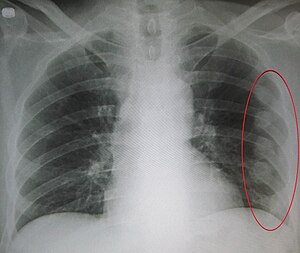Rib fracture
| Rib fracture | |
|---|---|
 |
|
| An X ray showing multiple old fractured ribs of the person's left side as marked by the oval. | |
| Classification and external resources | |
| Specialty | emergency medicine |
| ICD-10 | S22.3-S22.4 |
| ICD-9-CM | 807.0, 807.1 |
| DiseasesDB | 11553 |
| eMedicine | emerg/204 radio/609 |
| MeSH | D012253 |
A rib fracture is a break or fracture in one or more of the bones making up the rib cage. Fractures of the first and second ribs may be more likely to be associated with head and facial injuries than other rib fractures. The middle ribs are the ones most commonly fractured. Fractures usually occur from direct blows or from indirect crushing injuries. A rib fracture has the complication of potentially causing a pulmonary contusion. Rib fractures are usually quite painful because the ribs have to move to allow for breathing. When several ribs are broken in several places a flail chest results, and the detached bone sections will move separately from the rest of the chest.
Rib fractures can occur with or without direct trauma during recreational activity. Cardiopulmonary resuscitation, commonly known as CPR, has also been known to cause thoracic injury, including but not limited to rib and sternum fractures. They can also occur as a consequence of diseases such as cancer or rheumatoid arthritis. While for elderly individuals a fall can cause a rib fracture, in adults automobile accidents are a common event for such an injury.
Signs one may have a broken rib are:
Because children have more flexible chest walls than adults do, their ribs are more likely to bend than to break; therefore the presence of rib fractures in children is evidence of a significant amount of force and may indicate severe thoracic injuries such as pulmonary contusion. Rib fractures are also a sign of more serious injury in elderly people.
There is no specific treatment for rib fractures, but various supportive measures can be taken. In simple rib fractures, pain can lead to reduced movement and cough suppression; this can contribute to formation of secondary chest infection. Flail chest is a potentially life-threatening injury and will often require a period of assisted ventilation. Flail chest and first rib fractures are high-energy injuries and should prompt investigation of damage to underlying viscera (e.g., lung contusion) or remotely (e.g., cervical spine injury). Spontaneous fractures in athletes generally require a cessation of the cause, e.g., time off rowing, while maintaining cardiovascular fitness.
...
Wikipedia
